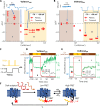Photophysics-informed two-photon voltage imaging using FRET-opsin voltage indicators
- PMID: 39772682
- PMCID: PMC11708879
- DOI: 10.1126/sciadv.adp5763
Photophysics-informed two-photon voltage imaging using FRET-opsin voltage indicators
Abstract
Microbial rhodopsin-derived genetically encoded voltage indicators (GEVIs) are powerful tools for mapping bioelectrical dynamics in cell culture and in live animals. Förster resonance energy transfer (FRET)-opsin GEVIs use voltage-dependent quenching of an attached fluorophore, achieving high brightness, speed, and voltage sensitivity. However, the voltage sensitivity of most FRET-opsin GEVIs has been reported to decrease or vanish under two-photon (2P) excitation. Here, we investigated the photophysics of the FRET-opsin GEVIs Voltron1 and Voltron2. We found that the previously reported negative-going voltage sensitivities of both GEVIs came from photocycle intermediates, not from the opsin ground states. The voltage sensitivities of both GEVIs were nonlinear functions of illumination intensity; for Voltron1, the sensitivity reversed the sign under low-intensity illumination. Using photocycle-optimized 2P illumination protocols, we demonstrate 2P voltage imaging with Voltron2 in the barrel cortex of a live mouse. These results open the door to high-speed 2P voltage imaging of FRET-opsin GEVIs in vivo.
Figures




Update of
-
Photophysics-informed two-photon voltage imaging using FRET-opsin voltage indicators.bioRxiv [Preprint]. 2024 Apr 2:2024.04.01.587540. doi: 10.1101/2024.04.01.587540. bioRxiv. 2024. Update in: Sci Adv. 2025 Jan 10;11(2):eadp5763. doi: 10.1126/sciadv.adp5763. PMID: 38617370 Free PMC article. Updated. Preprint.
Similar articles
-
Photophysics-informed two-photon voltage imaging using FRET-opsin voltage indicators.bioRxiv [Preprint]. 2024 Apr 2:2024.04.01.587540. doi: 10.1101/2024.04.01.587540. bioRxiv. 2024. Update in: Sci Adv. 2025 Jan 10;11(2):eadp5763. doi: 10.1126/sciadv.adp5763. PMID: 38617370 Free PMC article. Updated. Preprint.
-
Two-Photon Lifetime Imaging of Voltage Indicating Proteins as a Probe of Absolute Membrane Voltage.Biophys J. 2015 Sep 1;109(5):914-21. doi: 10.1016/j.bpj.2015.07.038. Biophys J. 2015. PMID: 26331249 Free PMC article.
-
Imaging neural spiking in brain tissue using FRET-opsin protein voltage sensors.Nat Commun. 2014 Apr 22;5:3674. doi: 10.1038/ncomms4674. Nat Commun. 2014. PMID: 24755708 Free PMC article.
-
Current progress in genetically encoded voltage indicators for neural activity recording.Curr Opin Chem Biol. 2016 Aug;33:95-100. doi: 10.1016/j.cbpa.2016.05.023. Epub 2016 Jun 17. Curr Opin Chem Biol. 2016. PMID: 27322400 Review.
-
Imaging Voltage with Microbial Rhodopsins.Front Mol Biosci. 2021 Aug 25;8:738829. doi: 10.3389/fmolb.2021.738829. eCollection 2021. Front Mol Biosci. 2021. PMID: 34513932 Free PMC article. Review.
Cited by
-
Voltage Imaging with Periodic Structured Illumination.bioRxiv [Preprint]. 2025 Jul 30:2025.07.24.666645. doi: 10.1101/2025.07.24.666645. bioRxiv. 2025. PMID: 40766480 Free PMC article. Preprint.
-
Robotic Fast Patch Clamp in Brain Slices Based on Stepwise Micropipette Navigation and Gigaseal Formation Control.Sensors (Basel). 2025 Feb 13;25(4):1128. doi: 10.3390/s25041128. Sensors (Basel). 2025. PMID: 40006358 Free PMC article.
-
Miniaturized widefield microscope for high speed in vivo voltage imaging.bioRxiv [Preprint]. 2025 Aug 6:2025.08.04.668551. doi: 10.1101/2025.08.04.668551. bioRxiv. 2025. PMID: 40799544 Free PMC article. Preprint.
-
Optical constraints on two-photon voltage imaging.bioRxiv [Preprint]. 2024 May 17:2023.11.18.567441. doi: 10.1101/2023.11.18.567441. bioRxiv. 2024. Update in: Neurophotonics. 2024 Jul;11(3):035007. doi: 10.1117/1.NPh.11.3.035007. PMID: 38014011 Free PMC article. Updated. Preprint.
-
A novel rhodopsin-based voltage indicator for simultaneous two-photon optical recording with GCaMP in vivo.bioRxiv [Preprint]. 2024 Nov 17:2024.11.15.623698. doi: 10.1101/2024.11.15.623698. bioRxiv. 2024. PMID: 39605646 Free PMC article. Preprint.
References
-
- Adam Y., All-optical electrophysiology in behaving animals. J. Neurosci. Methods 353, 109101 (2021). - PubMed
-
- Abdelfattah A. S., Zheng J., Singh A., Huang Y.-C., Reep D., Tsegaye G., Tsang A., Arthur B. J., Rehorova M., Olson C. V. L., Shuai Y., Zhang L., Fu T.-M., Milkie D. E., Moya M. V., Weber T. D., Lemire A. L., Baker C. A., Falco N., Zheng Q., Grimm J. B., Yip M. C., Walpita D., Chase M., Campagnola L., Murphy G. J., Wong A. M., Forest C. R., Mertz J., Economo M. N., Turner G. C., Koyama M., Lin B.-J., Betzig E., Novak O., Lavis L. D., Svoboda K., Korff W., Chen T.-W., Schreiter E. R., Hasseman J. P., Kolb I., Sensitivity optimization of a rhodopsin-based fluorescent voltage indicator. Neuron 111, 1547–1563.e9 (2023). - PMC - PubMed
-
- Adam Y., Kim J. J., Lou S., Zhao Y., Xie M. E., Brinks D., Wu H., Mostajo-Radji M. A., Kheifets S., Parot V., Chettih S., Williams K. J., Gmeiner B., Farhi S. L., Madisen L., Buchanan E. K., Kinsella I., Zhou D., Paninski L., Harvey C. D., Zeng H., Arlotta P., Campbell R. E., Cohen A. E., Voltage imaging and optogenetics reveal behaviour-dependent changes in hippocampal dynamics. Nature 569, 413–417 (2019). - PMC - PubMed
-
- Kralj J. M., Hochbaum D. R., Douglass A. D., Cohen A. E., Electrical spiking in Escherichia coli probed with a fluorescent voltage indicating protein. Science 333, 345–348 (2011). - PubMed
MeSH terms
Substances
Grants and funding
LinkOut - more resources
Full Text Sources

